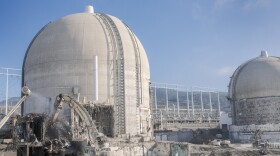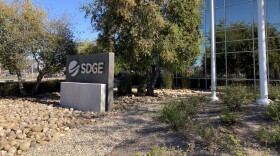The movement of goods through the port of San Diego via ships, trucks and trains spews about 256 million pounds of greenhouse gases each year. Many of the city's poorest people live near the port's 10th Avenue Marine Terminal in Barrio Logan and they say the bad air is making them sick. Their complaints have spurred little action until recently. KPBS Reporter Amita Sharma has more.
090428-asthmafeature-as.jpg
(Photo: Alejandra Baza stands with her daughter, Erica, outside of their apartment in Barrio Logan, near the 10th Avenue Marine Terminal. Amita Sharma/KPBS)
Over 20 percent of the children living in Barrio Logan have asthma. That's nearly triple the national average. And the rate of hospitalization for asthma in this community is 54 percent higher than the county average.
Alejandara Baza of Barrio Logan worries her three-year-old daughter you just heard might get the chronic lung disease. Her 11-year-old son was recently diagnosed with asthma. He carries an inhaler in his backpack. She's convinced her family's health troubles are connected to port-related business and she feels powerless.
"Powerlessness- I feel powerless. My kids want to go outside and run and exercise and you go outside and start sneezing . You go outside and start coughing," says Baza.
The Environmental Health Coalition says not all of the asthma in Barrio Logan can be blamed on the port of San Diego's 10th Avenue Marine Terminal. But the group says it's a huge contributor. A thousand trucks a week pass through the terminal.
Just feet away from the Mercado Apartments where Baza lives, trucks carrying port cargo idle on the street for hours preparing to enter a distribution center …. all the while releasing emissions containing toxic pollutants like benzene and tiny particles. When those fine particles get into the lungs, they can create serious health problems.
The black soot from the diesel fumes covers the inside of Alejandra's apartment each day. An air filter in the middle of her place also fills up with diesel dust within minutes after she empties it..
"There's the result…….here's the proof…….of all those trucks that are passing by everyday all the time…and all that dust is getting inside even though I have the windows closed. I have to open them a little bit because we can't be shut-ins," she says.
"It is absolutely obscene how close these trucks are to the Mercado Apartments."
But the Environmental Health Coalition's Tony LoPresti says it's not just the trucks causing the health problems, it's the ships bringing in bananas each week that are the biggest polluters.
"They are literally docked and running their engines for nearly 3 days at a time," says LoPresti. "They are powering 500 refrigerated containers. so the amount of diesel pollution that's emitted during those three days basically flows right into the community."
Just this month, the port of San Diego's commissioners adopted a clean-air plan that includes applying for federal stimulus money to build berths where ships could use electricity while dockside rather than burn diesel.
The Environmental Health Coalition's Diane Takvorian says it's been a nearly 20-year struggle to convince the port to take the 10th Avenue Marine Terminal's health effects on Barrio Logan seriously.
"When we first started working with the port., it was very hard for us to get a seat at the table The doors were literally shut."
The Environmental Health Coalition credits new Port Commissioner Scott Peter's ascension to the agency's environmental committee as the key to the port's willingness to electrify 10th Avenue. He says he's focused on cleaning up port pollution in Barrio Logan.
"This is the biggest environmental justice issue going on right now," says Peters.
But what happens if the port doesn't receive federal stimulus money? The Environmental Health Coalition says it expects the port to move ahead with ship electrification regardless.
There is also supposed to be relief on the way for residents with diesel-churning trucks travelling through their neighborhoods. New standards require diesel trucks to have cleaner engines by next year. But the port says state funding for that project has been frozen…although it will continue with the program using its own money.
In the meantime, Alejandra Baza says she contemplates moving her family out of their apartment. But it's government-subsidized housing so even if she does leave, there's a long list of people waiting to move in.
Amita Sharma, KPBS News.





